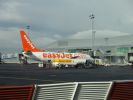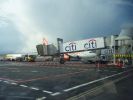

Of course airliners need fuel. A lot of fuel. Fuel quantities are usually measured in kilograms (or other weight units) instead of litres (or other volume units), because weight is critical in many calculations. To calculate how much fuel an aircraft needs for a particular journey, the properties of the aircraft, including its weight, must be known. But wait, adding fuel to the aircraft will make it heavier, and airliners must carry reserve fuel, so the calculations are very complex and beyond the scope of this website.
Jet engines and turboprops use kerosene as fuel, while piston engines use aviation gas (avgas). An Airbus A319 can hold about 30,000 litres (24,000 kg) of fuel, Boeing 747 around 215,000 litres (172,000 kg), and the huge Airbus A380 up to 350,000 litres (280,000 kg). Although these numbers are huge, airliners require just a little less fuel per mile per passenger than an average car (assuming average car and airplane occupancy) because they usually carry a lot of people over long distances. In the airline industry, an average fuel consumption per passenger per 100 kilometers is a little over 4 liters of fuel and some aircraft and some airlines can get it down to about 3 litres of kerosene per passenger per 100 kilometers.
Most airports use refuelling trucks to refuel aircraft. Some of the largest airports have fuel pipes leading all the way to the aircraft stands, so they can refuel without the truck, but this is still uncommon. You can see the refuelling truck in action on the following pictures.
Copyright notice: Text and images copyright by Michal Řeháček.